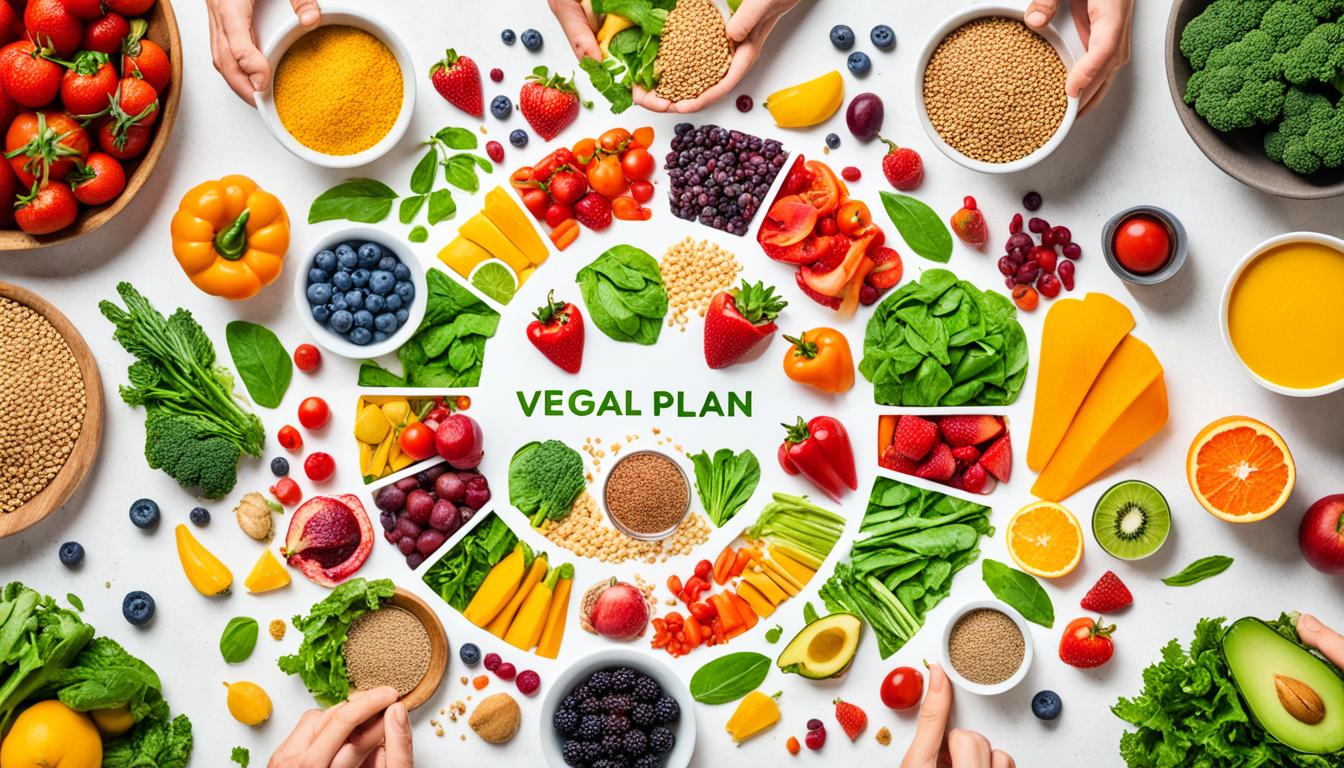
Let me paint a picture for you. It’s Sunday evening, and I’m standing in my kitchen, contemplating what to make for dinner. As a health-conscious individual, I’ve recently embraced a plant-based lifestyle and have been exploring the world of vegan cooking. However, navigating the sea of vegan recipes and ingredients can be overwhelming at times. That’s when I discovered the power of meal planning.
Meal planning has revolutionized the way I approach my vegan meals. It not only saves me time and effort but also ensures that I always have nutritious and delicious plant-based meals ready to go. Whether you’re a seasoned vegan or just starting out on your vegan journey, mastering the art of meal planning is key to enjoying the benefits of a vegan lifestyle.
In this article, I will share with you essential tips and strategies for effective vegan meal planning, as well as provide you with a sample menu to get you started. From creating a vegan shopping list to incorporating various nutrient-rich ingredients into your meals, I’ll cover everything you need to know to make your vegan meal planning a breeze. So, let’s dive in and explore the world of plant-based deliciousness!
The Benefits of Veganism for Health
Research shows that a well-rounded vegan diet can have numerous positive effects on overall health. Adopting a vegan lifestyle has been linked to significant improvements in heart health, weight management, blood sugar control, joint pain relief, and even a reduced risk of certain types of cancer.
A vegan diet, which emphasizes plant-based foods and eliminates animal products, can help lower blood pressure and reduce the risk of hypertension. Additionally, studies have shown that individuals following a vegan diet often have lower body mass indexes (BMI) compared to non-vegans, which can contribute to weight loss and healthy weight management.
Vegan diets can also have a positive impact on cholesterol levels. By avoiding high-cholesterol animal foods, such as meat and dairy products, vegans generally have lower levels of total cholesterol and LDL (bad) cholesterol, reducing the risk of cardiovascular diseases.
Moreover, adopting a vegan diet can be beneficial for blood sugar control, making it particularly beneficial for individuals with diabetes or those at risk of developing the condition. Plant-based diets tend to be rich in fiber, whole grains, fruits, and vegetables, which can help regulate blood sugar levels and improve insulin sensitivity.
Many individuals also choose a vegan lifestyle to alleviate joint pain, such as that caused by conditions like osteoarthritis. Plant-based diets have been shown to have anti-inflammatory properties, which can help reduce joint pain and inflammation, improving overall joint health and mobility.
Additionally, research suggests that following a vegan diet may contribute to a decreased risk of certain types of cancer. Plant-based diets are typically rich in antioxidants, vitamins, and minerals that play a vital role in reducing cancer risk. Studies have shown that vegans have a lower incidence of breast and prostate cancers compared to non-vegans.
Benefits of Veganism for Health:
| Health Aspect | Benefits of Veganism |
|---|---|
| Heart Health | Lower risk of high blood pressure and decreased levels of total and LDL cholesterol |
| Weight Loss | Lower body mass index (BMI), aiding in healthy weight management |
| Blood Sugar Control | Improved regulation of blood sugar levels and increased insulin sensitivity |
| Joint Pain Relief | Anti-inflammatory properties helping to alleviate joint pain and improve mobility |
| Cancer Risk Reduction | Lower incidence of certain types of cancers, such as breast and prostate cancer |
Vegan Meal Planning: Tips and Strategies
Planning a vegan meal requires a variety of nutrient-rich ingredients. A well-balanced vegan diet should include a wide variety of fruits, vegetables, whole grains, proteins, and healthy fats.
A sample vegan shopping list can help you get started with selecting the right ingredients. Include foods like nuts, seeds, legumes, soy products, and nutritional yeast for protein. Avocado oil, coconut oil, and olive oil are good choices for healthy fats.
It’s important to choose whole, unprocessed foods instead of highly processed vegan products. Experiment with different spices and condiments to add flavor to your meals. And don’t forget about snack foods and sweeteners to satisfy your cravings and add variety to your diet.

